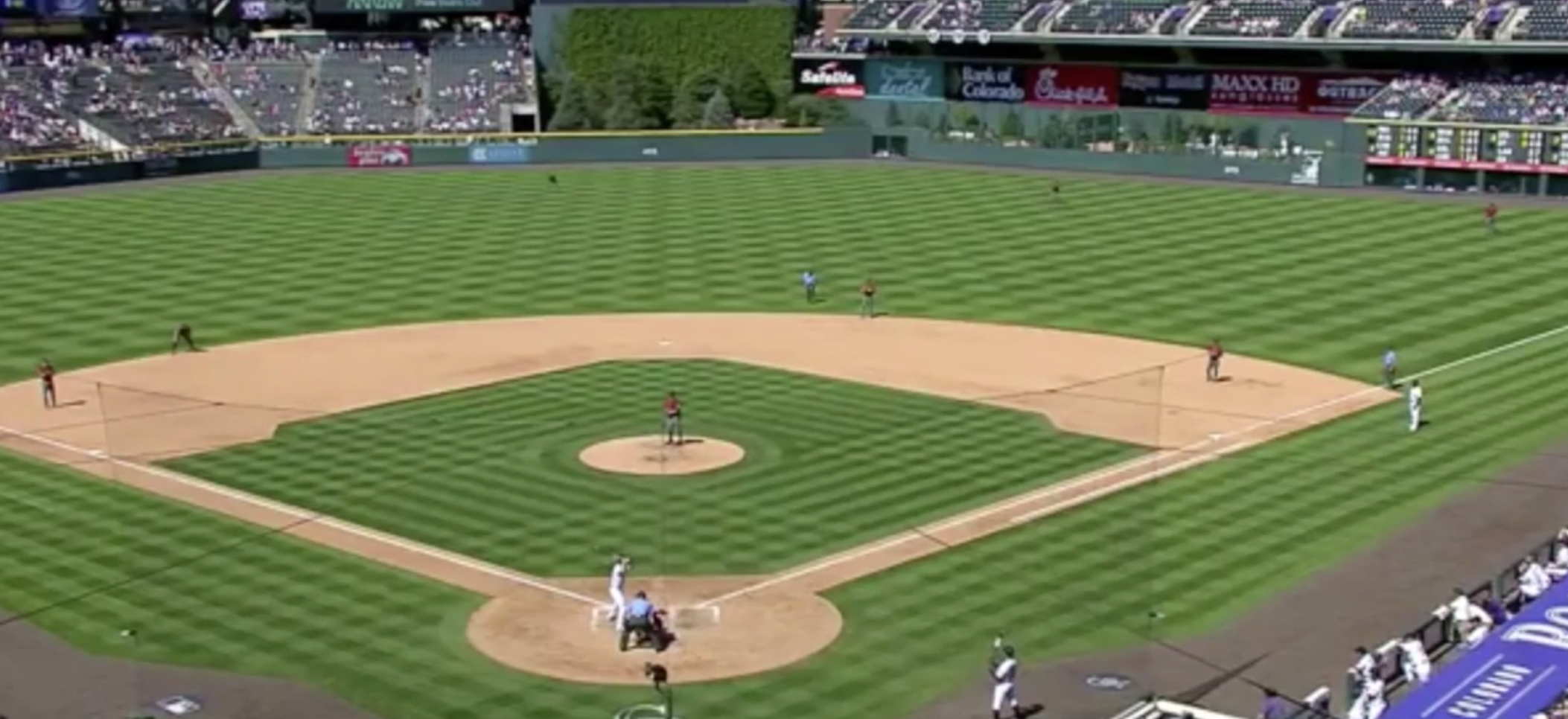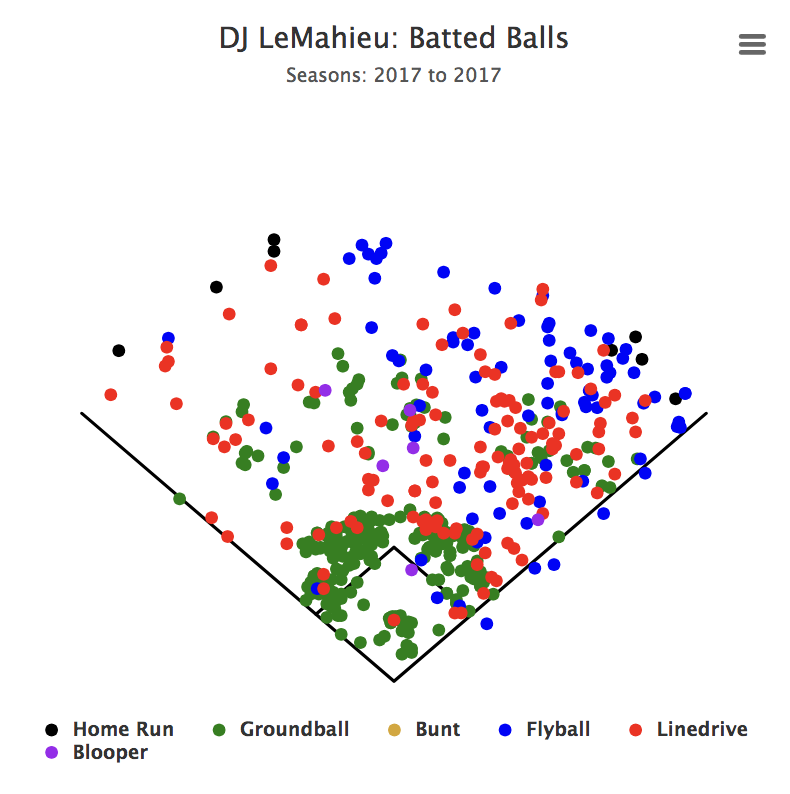DJ LeMahieu Is Up to Something
PITTSBURGH — As defensive shifts — or, at least, infields shifts — have become an everyday part of the game, it takes a lot to get our attention. The Diamondbacks’ shift against Rockies second baseman DJ LeMahieu last season got our attention.
In case you’ve forgotten, borrowing from a post from last season detailing the alignment:

That gets our attention.
Diamondbacks manager Torey Lovullo was aware of the implications. After the game last fall, he relayed his thoughts to Nick Piecoro of the Arizona Republic.
“It’s a super-shift times 10,” Lovullo said. “You’ve never really seen anything like it.”
“With nobody in left field, it could be an inside-the-park home run… You’re kind of holding your breath.”
In the fifth inning in the first game of the extreme shift, on its third attempt, the gambit worked.
https://gfycat.com/CraftyBlackGalapagoshawk
That’s a line drive to “center fielder” A.J. Pollock, catching the ball after just a few quick steps to his left.
A.J. Pollock's catch on DJ LeMahieu's lineout in 5th inning last night. Almost certainly wouldn't have made w/o shift. pic.twitter.com/BoxpAeUUqC
— Daniel Kramer (@DKramer_) September 2, 2017
LeMahieu has always had some of the most dramatic opposite-field tendencies in the game. He’s been Joe Mauer– and Derek Jeter-like. He has the sixth-lowest pull rate on fly balls last season. That was his career norm until this season. LeMahieu appears to have made a dramatic pivot in his batted-ball profile.
| Season | Team | PA | Pull% | Cent% | Oppo% |
|---|---|---|---|---|---|
| 2014 | COL | 173 | 12.7 | 28.3 | 58.9 |
| 2015 | COL | 208 | 8.9 | 36.5 | 54.8 |
| 2016 | COL | 234 | 11.9 | 36.7 | 52.3 |
| 2017 | COL | 232 | 12.0 | 31.9 | 56.0 |
| 2018 | COL | 27 | 18.5 | 48.2 | 33.3 |
LeMahieu has already hit four home runs to left field after hitting two in that location all of last year, four in 2016, and two in 2015.
Consider his spray chart from last season:

And compare that above image to his 2018 chart:

Another way to consider the change is by the data-density charts at Baseball Savant.
Here’s LeMahieu’s line drives and fly balls from last season:

And the following are LeMahieu’s air balls from this season:

Notice a difference?
It’s early, sure, but LeMahieu has produced this change early this season just after we saw the dramatic alignments by the Diamondbacks and Padres to close last season. Curious, I approached LeMahieu in the visiting clubhouse Tuesday at PNC Park to ask him just what he was up to.
“I didn’t go into the offseason thinking I needed to beat any outfield shift,” LeMahieu told FanGraphs.
While LeMahieu claims he was not motivated by the alignments, he did say he has been trying to add more pull-side power to his game.
“I go into every offseason trying to drive the ball more. It’s just translated a little bit better this year,” LeMahieu said. “Maybe just trying to drive the ball a little bit more up the middle. But I am really taking the same approach that I always have. I just feel my practice in the cage during the offseason is translating a little better…
“I know all the numbers. I know I hit the ball really hard but not always in the air. But I feel like I am a pretty good player, so it’s about what you are willing to sacrifice.”
While LeMahieu has changed his batted-ball direction, he hasn’t stopped pounding balls into the turf. His average launch angle entering play Wednesday was 1.5 degrees via Statcast, which is actually lower than his mark of 2.8 degrees last season.
Rockies assistant hitting instructor Jeff Salazar offered further insight on the development of LeMahieu. Salazar said LeMahieu is not consciously thinking about pulling the ball; rather, he’s made an adjustment to develop a more “linear” bat path, which has allowed him to advance his contact point, on occasion, further out in front of the plate.
“An adjustment he’s made this year — which is why we are seeing him hit to the pull side — is that he’s learning to not just manipulate the bat that way, he’s learning to take his hands and catch the ball further out in front of him,” Salazar said. “The ball is going to have a better launch and go to pull side. He’s not trying to pull it, he’s trying to be more efficient in how his barrel attacks the ball. He doesn’t have the conscious thought, ‘I need to pull the ball.'”
To execute this, Salazar said LeMahieu is using his legs better in his swing, hitting from a stronger base, and beginning his swing earlier.
Consider a home-run swing from last week:
https://gfycat.com/TangibleImpracticalBluebird
Below is a still image from that GIF. This certainly appears to be a hitter with a contact point that is further out in front of the plate.

The following is a swing on an elevated cutter from last season, which LeMahieu lined to first base on the right side, as he typically did when getting the ball off the ground.
https://gfycat.com/CapitalEvilIggypops
This is just a small sampling of swings, but LeMahieu did not turn on the ball as dramatically as he has on his home-run swings of 2018.

LeMahieu is still comfortable letting the ball travel and hitting it deeper in the zone.
“That’s his default setting,” Salazar said. “You watch batting practice and the pitcher will throw in, and you think he’ll have trouble with it, but he’s so good at taking the bat and flipping [the ball] that way. He was born to do it.”
LeMahieu can still be effective in letting the ball travel and going the other way, but he’s perhaps diversified his skill set in 2018.
The other early change is that LeMahieu, always an elite contact hitter, has been more much selective as a hitter dropping his out-of-zone swing rate from 26.8% last season — 29.1% for his career — to 15.6% early this season. He’s dropped his swing rate by seven percentage points to 34.1%.
LeMahieu appears to be identifying the pitches he can damage, pitches generally elevated and slightly inside.
Consider his swing rate by zone last season:

And this season:

LeMahieu was not terribly revealing in my conversation with him, but he said he is not a fly-ball revolutionary; he’s not trying to get the ball in the air like Justin Turner or Daniel Murphy have done.
But he is doing something different. Perhaps most important is he’s being more selective and looking for pitches he can contact out front to pull and drive. Perhaps this is just the maturation of a quality hitter, adding power as he develops. What we do know is the Diamondbacks will think twice before employing their LeMahieu shift again.
A Cleveland native, FanGraphs writer Travis Sawchik is the author of the New York Times bestselling book, Big Data Baseball. He also contributes to The Athletic Cleveland, and has written for the Pittsburgh Tribune-Review, among other outlets. Follow him on Twitter @Travis_Sawchik.

IIRC, beginning his swing earlier was the one weird trick that turned Jose Bautista into Joey Bats.
You are right. I remember reading that and thinking “that’s all there is to hitting 50 homers, swing earlier?”
There was also a quote I read her on Fangraphs from David Ortiz who said something like “plan to swing early and then swing even earlier than that”.